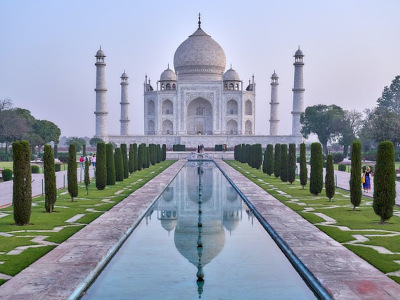The Taj Mahal stands on the right bank of the Yamuna River in a large Mughal garden spanning almost 17 hectares in the Agra District of Uttar Pradesh. Emperor Shah Jahan built it in memory of his wife, Mumtaz Mahal, starting construction in 1632 AD and finishing in 1648 AD. The mosque, guest house, and main gateway are on the south side, with the outer courtyard and cloisters completed in 1653 AD. Various historical and Quaranic inscriptions in Arabic script help in dating the Taj Mahal. Skilled artisans from the empire, Central Asia, and Iran were involved in its construction, with Ustad-Ahmad Lahori as the main architect.
The Taj Mahal is a masterpiece of Indo-Islamic architecture. It is a meticulously planned structure, designed with perfect symmetry. The main elements are placed along a central axis, emphasizing bilateral symmetry. The building is constructed using brick-in-lime mortar, covered with red sandstone and marble, and adorned with intricate inlay work made of precious and semi-precious stones. In contrast to the marble tomb at the center, the mosque and guest house in the Taj Mahal complex are made of red sandstone. Both buildings have a spacious platform in front of their terraces. The mosque and guest house are identical in structure, featuring a long prayer hall with three vaulted bays arranged in a row and a prominent central portal. The arches and spandrels of the portal are covered in white marble, decorated with floral stone intarsia and rope molding along the edges.
The Taj Mahal’s uniqueness comes from innovative planning by Shah Jahan’s horticulture planners and architects. One brilliant idea was placing the tomb at one end of the garden instead of the center, enhancing the depth of the distant view. The raised tomb sits on a square platform, with minarets extending beyond the corners. The tomb’s exterior is square with chamfered corners, and the octagonal chamber inside holds the cenotaphs of Mumtaz Mahal and Shah Jahan. The marble lattice screen surrounding the cenotaphs is beautifully crafted with precious stones and intricate inlay work.
Protection of the Taj Mahal
To protect the Taj Mahal from pollution, an area of 10,400 sq km has been designated. The Supreme Court of India has banned the use of coal or coke in industries located in the Taj Trapezium Zone (TTZ) and has mandated the use of natural gas or the relocation of these industries outside the TTZ. The TTZ includes 40 protected monuments, including the Taj Mahal, Agra Fort, and Fatehpur Sikri. Furthermore, the Archaeological Survey of India manages the Taj Mahal complex and ensures its legal protection. Various laws and regulations, such as the Ancient Monument and Archaeological Sites and Remains Act 1958 and Rules 1959, are in place to administer the property and its surrounding areas. Additional laws are also in place to protect the property from development in its surroundings. Additionally, adequate funding from the federal government is provided for the buffer areas and the overall conservation, preservation, and maintenance of the complex. The supervising archaeologist of the Agra Circle supervises activities at the site. An integrated management plan is necessary to maintain the property’s existing conditions and effectively manage the pressure from visitors. The plan should also provide guidelines for infrastructure development and establish a comprehensive public-use plan.
Sources:
https://whc.unesco.org/en/list/252/



